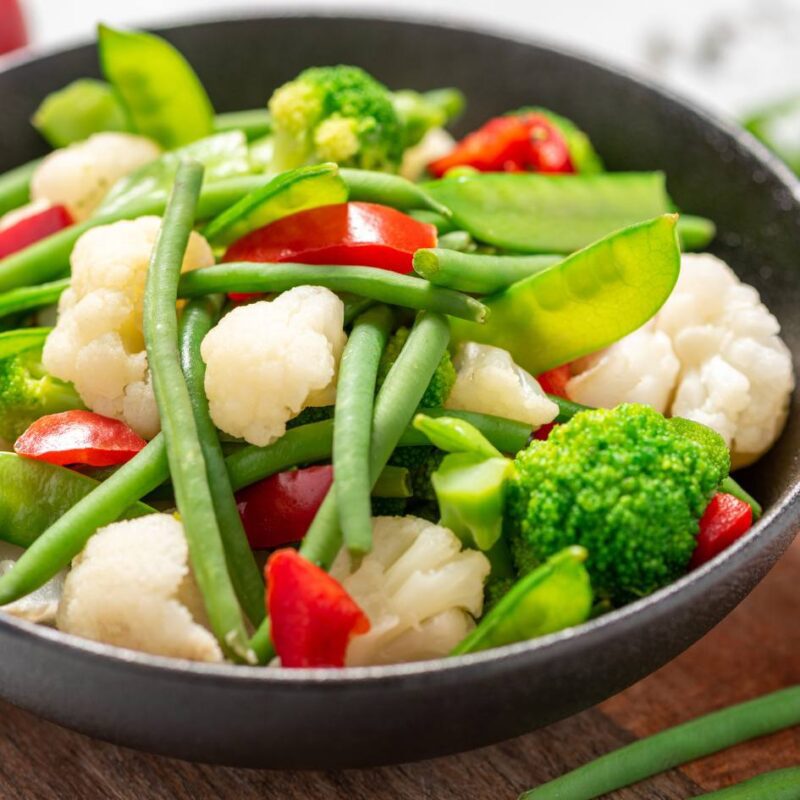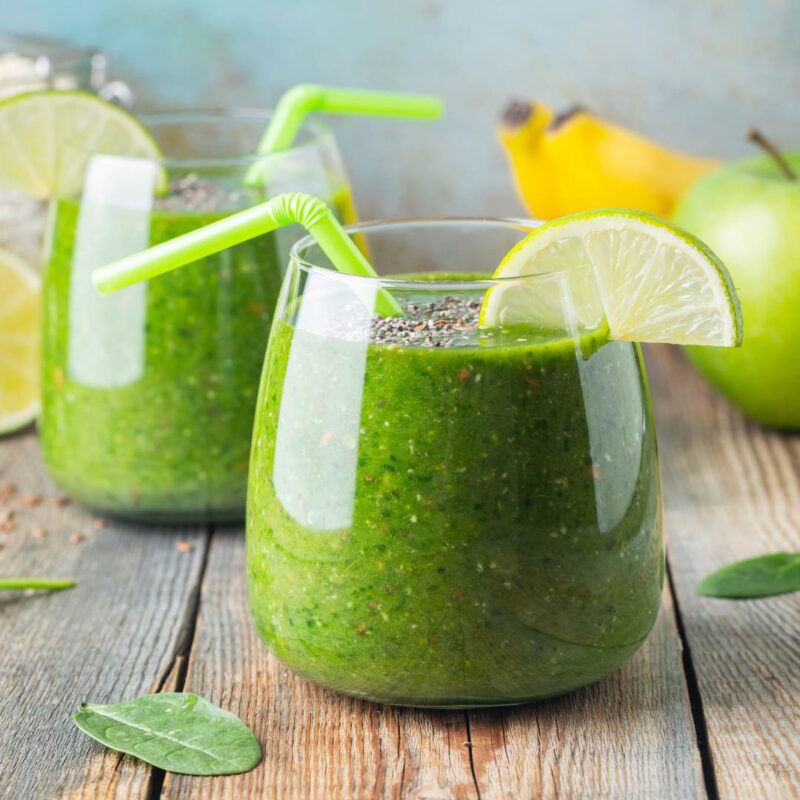
This post may contain affiliate links. Disclosure here.
Progesterone is a sex hormone that plays an important role in regulating the menstrual cycle, preparing for conception, and in maintaining pregnancy. When women reach peri-menopause and menopause, progesterone levels, along with estrogen, decrease. This decrease causes many of the negative impacts associated with menopause – hot flashes, night sweats, weight gain, low libido and the list goes on.
Increasing progesterone naturally through one’s diet could boost progesterone levels without having to experience the unwanted side effects of synthetic hormones. Because progesterone is a hormone, it is not found in food; however there are foods that increase progesterone production and are beneficial to add to our diet.
Save this Pin for quick reference.

What is Progesterone?
Progesterone is a sex hormone produced by both both men and women. In woman, it is first synthesized in the adrenal glands, the corpus luteum (located in the ovaries) starts to produce progesterone in increasing amounts after ovulation, and the placenta is the primary source of progesterone during pregnancy.
Progesterone is crucial for healthy fertility and pregnancy, but is still an important hormone whether you are trying to get pregnant or not. Progesterone helps balance estrogen, the other primary sex hormone in those assigned female at birth. Without the balance, symptoms of peri-menopause and menopause can get worse.
What are Normal Progesterone Levels?
Progesterone levels are measured by a blood test. Progesterone levels fluctuate during the monthly cycle, but the following chart gathered from HealthLine depicts normal levels throughout ovulation and pregnancy.
In women approaching menopause, progesterone levels can be sporadic, depending on the frequency of ovulation. During menopause, progesterone eventually falls below 0.20 ng/mL.

What Can Cause Low Progesterone Levels?
Peri-menopause & Menopause
Progesterone levels decrease naturally when women are getting near menopause and then drop quite a bit thereafter.
Estrogen Dominance
Estrogen dominance is one of the main reasons of low progesterone levels. Progesterone and estrogen have a symbiotic relationship, where one is needed to help control the other. If estrogen is high, then progesterone is low.
Factors that may cause estrogen dominance:
- High body fat
- Low melatonin results in higher estrogen
- An overloaded liver can cause high estrogen, because the liver cannot conjugate hormones as efficiently
- Constipation can cause higher estrogen, because estrogen is eliminated through the digestive tract
- Pesticides found on fruits and vegetables are known hormone disruptors, causing excess estrogen
- Petrochemical compounds found in general consumer products, such as creams, lotions, shampoos, etc. are sources of zenoestrogen
Stress
Both progesterone and cortisol share the same biochemical pathway and are made from the same precursor hormone – pregnenolone. When stressed, the body produces cortisol instead of progesterone. The body deals with stress before anything else, including the reproductive system.
Obesity
Fat cells carry an enzyme that converts adrenal steroids to estrogen. The more fat cells, the more estrogen is produced.
Hypothyroidism
With hypothyroidism, the thyroid gland cannot produce T3 and T4. These are the hormones that regulate the whole endocrine system, allowing normal production of progesterone.
Alcohol
According to the an article in Alcoholism: Clinical and Experimental Research, drinking alcohol can cause a spike in estrogen levels and a decline in progesterone in premenopausal women.
Excessive Exercise
Both progesterone and cortisol share the same biochemical pathway and are made from the same precursor hormone. Anything that creates stress in the body (e.g., intense exercise) signals the adrenal glands to make stress hormones over other hormones.
Caffeine
Caffeine encourages higher cortisol levels and the adrenals will convert progesterone to meet the demand for cortisol.
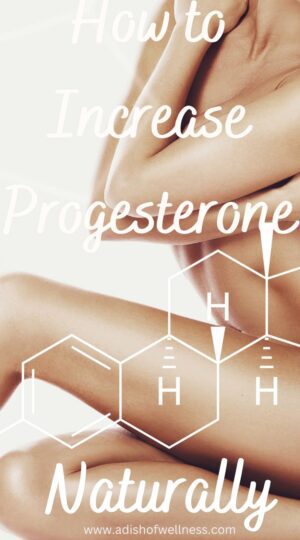
What Happens if Progesterone is Low?
Low progesterone levels can impact pregnancy, and can cause infertility or miscarriages. It can also cause irregular periods and spotting.
In peri-menopause or menopausal stages, low progesterone tends to cause hot flashes, low libido, dizziness, urinary incontinence, weight gain, night sweats, fibroids, poor sleep, and irritability.
What are Signs of Low Progesterone?
Progesterone has a great impact on mood, so if progesterone levels are low, you may feel moody, anxious, and depressed. You may also gain weight and retain water. Other signs are headaches, migraines, irregular periods, and/or spotting
Because progesterone stimulates collagen, low progesterone can cause sagging and aging skin. For healthy and glowing skin, read this post on Supplements for Healthy Glowing Skin. As mentioned earlier, it can also cause hot flashes, low libido, weight gain, night sweats, and irritability.
What Foods Increase Progesterone?
As always, eating a whole food diet, including lean quality protein, healthy fats, complex carbohydrates with an assortment of vegetables, fruits, and grains will ensure you are providing your body with the nutrients that it needs to thrive.
Adding specific foods that increase progesterone levels to your diet will also help. Many of these foods contain more than one of these healthy nutrients described below.
1. Eat Foods That Contain Healthy Fats
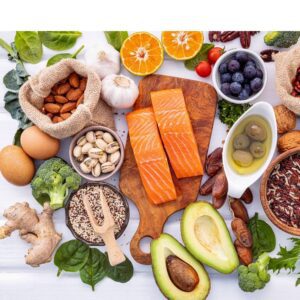
Hormones are made from protein and fat, and sex hormones are made from cholesterol. Eating a low-fat diet decreases the body’s production of estrogen and progesterone as described in this post on how dietary fat benefits hormones. So it is important to include healthy fats in your diet to balance your hormones.
Healthy fats are fats found in nature and are not processed (avoid trans fat). Healthy fats include saturated fats (in moderation), unsaturated fats, Omega 3 and Omega 6 essential fatty acids.
Fats, including healthy fats, are caloric at 9 calories per gram, so one should be mindful when adding fat to the diet. One should also be mindful to eat the healthiest fats possible.
Food Sources
Omega 3 – Fatty fish (salmon, tuna, mackerel, sardines), nuts, seeds, olive oil, flaxseed and walnut oil
Saturated – dairy, meat, coconut oil (in moderation)
Unsaturated – avocados, almonds, olives
2. Eat Foods that Contain Vitamin C
Vitamin C is absorbed in large amounts just before ovulation and stimulates the production of progesterone. One study discovered that vitamin C supplementation was associated with higher progesterone levels in peri-menopausal women.
Food Sources
Bell peppers, oranges, tomatoes, kale, citrus fruits, and cabbage
3. Eat Foods that Contain B6 (Pyridoxine)
Vitamin B6 (Pyridoxine) is essential for the development of the corpus luteum. After ovulation, the corpus luteum (a gland located in the ovaries) starts to produce progesterone in increasing amounts. Therefore, B6 is necessary for balancing hormones and preventing progesterone deficiency.
B6 is also necessary for the neutralization and detoxification of estrogen in the liver.
Food Sources
Eggs, spinach, carrots, salmon, sweet potato, avocado
4. Eat Foods That Contain Folic Acid
Folic Acid is necessary for the neutralization and detoxification of estrogen in the liver, which helps put estrogen and progesterone at a healthier balance within the body.
Food Sources
Legumes, leafy greens, beets, brussel sprouts
5. Eat Foods That Contain Lean Quality Protein
Progesterone is made from protein, fat, and cholesterol. Amino acids (AA) are the building blocks of protein and the body does not produce AA, so it needs to get it from the diet. One must consume all nine essential AA from the diet for overall wellbeing, including hormone health.
Foods Sources
Meat – Chicken, beef, salmon, tuna, eggs
Plant-based – Chickpeas, quinoa, tofu, lentils with rice
Try this delicious Salmon Teriyaki recipe for a lean protein and healthy fat source. Pair it with a whole grain rice and steamed vegetable for a complete meal.
Try this delicious Chickpea, Quinoa, and Tomato Salad for a complete plant-based protein meal, which includes excellent sources of vitamin C and iron.
6. Eat Foods that Contain Zinc
Zinc increases the production of the Follicle Stimulating Hormone (FSH), which in turn causes ovulation and leads to the production of progesterone.
Food Sources
Shellfish, pumpkin seeds, chickpeas, spinach, chicken
7. Eat Foods That Contain Magnesium
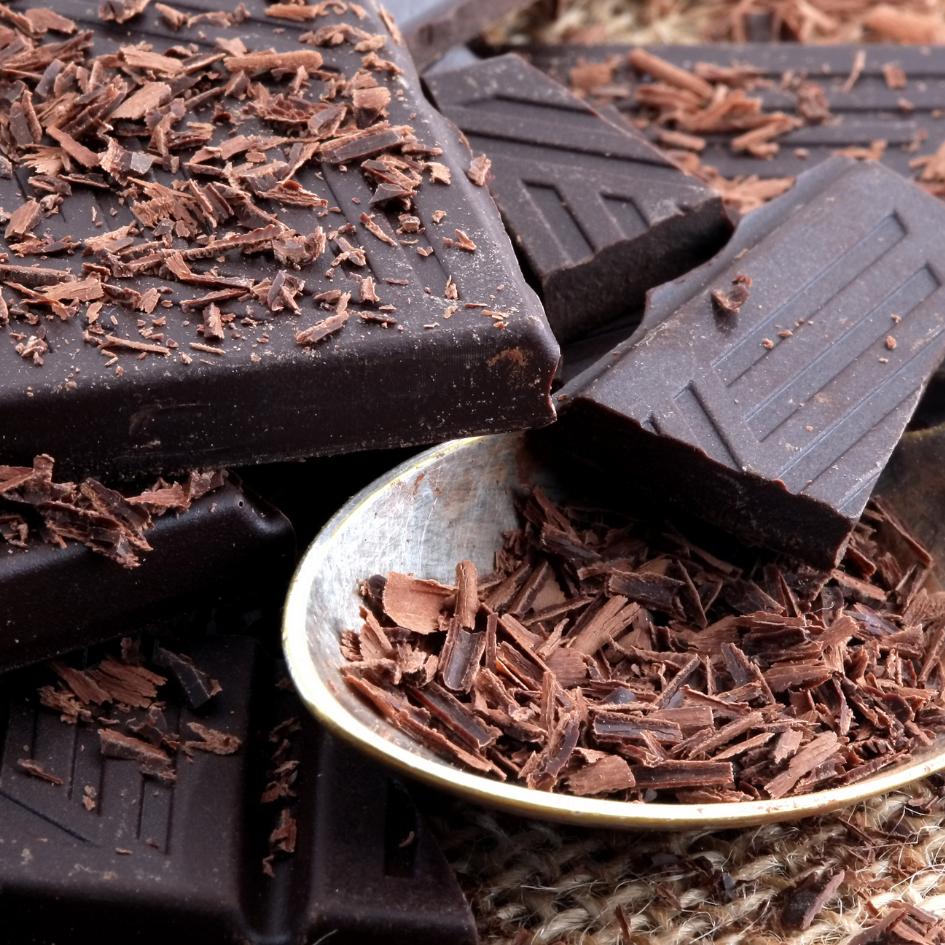
Magnesium boosts progesterone in the body by regulating the Follicle Stimulating Hormone (FSH), Luteinizing Hormone (LH) and Thyroid Stimulating Hormone (TSH).
Magnesium is also necessary for the neutralization and detoxification of estrogen in the liver.
Food Sources
Nuts, dark chocolate, spinach
8. Eat Foods That Contain L-Arginine
One of the nine essential amino acids that is especially important to progesterone production is L-arginine, which increases blood circulation so ovaries can function optimally. It also helps maintain hormone function, including progesterone.
Foods Sources
Chicken, fish, soy, nuts, seeds, brown rice
9. Eat Foods That Contain Fibre
Progesterone and estrogen work synergistically together. So if your estrogen levels are high, progesterone levels may be low. Fibre can help reduce estrogen levels and help progesterone work more effectively. Excess estrogen is eliminated via the colon.
Your body can absorb estrogen from certain foods (mentioned above) and the longer these foods take to get through your digestive system, the more estrogen is absorbed. Fibre helps improve your bowel movements and makes sure there is less time for estrogen to be absorbed into your system.
Estrogen detoxified by the liver is removed via the colon, so healthy digestive function is imperative.
Food Sources
Flaxseeds, chia seeds, bran, oats, quinoa
Extra Measures
Extra measures to ensure you are taking care of your endocrine system and supporting progesterone levels are as follows:
- Try to eat organic foods without pesticides. Refer to whole food rules.
- Exercise
- Detox liver
- Reduce stress
- Limit caffeine and alcohol
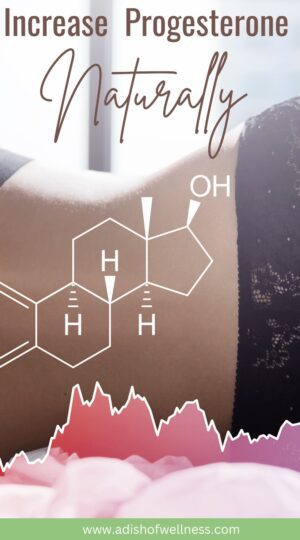
Conclusion
Progesterone is an important sex hormone made by both men and women. In women, progesterone regulates menstruation, prepares for ovulation, and maintains pregnancy. Progesterone is also required for overall well being and when levels go down, it impacts more than just fertility.
Low levels of progesterone can cause depression, anxiety, low libido, insomnia, weight gain, and many more negative factors. It is natural for progesterone to decrease as women near menopause, but instead of taking synthetic progesterone hormones, one can try to increase progesterone by incorporating foods that help produce progesterone naturally.


